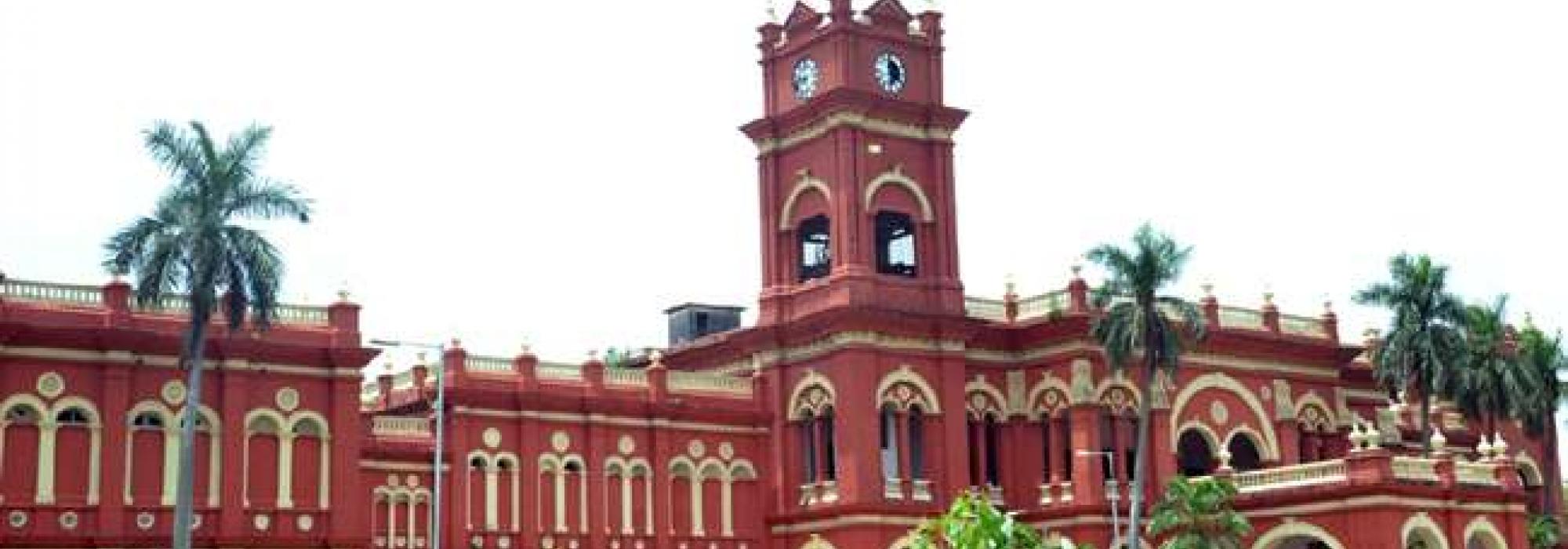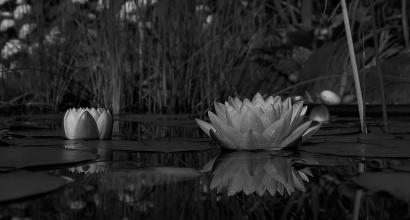Dispassion and Generosity
Sharma never sought publicity. He became totally dispassionate about the job he had taken up once it was complete. He authored a couple of columns in a few magazines under a different name[1]. Even his family members did not know for several years that he was the author of those articles.
The Darbhanga Sanskrit University conferred upon him an Honorary D.Litt. He was also felicitated with the Rājyotsava Award by the Government of Karnataka and Rāṣṭrapati Sammān by the Government of India. He received the title ‘Mahāmahopādhyāya’ from the Sanskrit University, Tirupati. He received all these with an attitude of equanimity – he was absolutely dispassionate. At times, these were sources of light humour to him.
Fate was cruel to Sharma in some respects. His wife, Kamalakshamma passed away in 1973, quite unexpectedly. This loss bothered Sharma throughout his life. His sons, Mr. Sadananda and Dr. Nagabhushana and daughters, Dr. Jayashri and Dr. Sharada Chaitra were well settled – and this gave him some solace.
Thorough Knowledge of the Śāstras
Ranganatha Sharma’s name caught my eye for the first time circa 1954. Back then, the weekly magazine Janapragati was popular. Sharma had written a [book] review article on Ti. Nam. Sri.’s Bhāratīya Kāvyamīmāmsè[2], which had been published then. It was an excellent review of a great work. When I enquired about him, I came to know that he was a lecturer at the Cāmarājendra Saṃskṛta Mahāpāṭhaśālā (in Chamarajapet, Bangalore). D V Gundappa too was curious to meet him. As soon as he got to know that DVG was eager to meet him, Ranganatha Sharma came to meet him. The rest is history. Their relationship seemed to be glued with a 53-grade cement – it was so lasting and deep. In the due course, he became a part of the Gokhale Institute. DVG even declared Sharma as the Kulapati (Chancellor) of that Vidyālaya (school).
We had occasions to witness and relish the scholarship of Sharma even outside the Gokhale Institute. The Sanātana Kalākṣetra, an institute I was closely associated with, organized a praśikṣaṇa-varga[3] in 1961–62 specially meant for teachers of nāṭya[4]. On that occasion, Sharma delivered lectures on the main concepts of the Nāṭyaśāstra. Upon listening to the lecture series, which went beyond mere listing technical definitions, my friend V S Kaushik was convinced about the correlation between nāṭya, yoga, and adhyātma. The lectures worked to bolster his thoughts. Sharma’s analysis of rasa-bhāva[5], citta-vṛttis[6], and alaṅkāra-śāstra was itself a treat filled with rasa.
There was another occasion like this. During 1964–65, as per the request of DVG, Sharma delivered a lecture series on the evolution of śabda-śāstra.[7] It was a memorable experience. We were not exposed to the traditional approach to śāstras; DVG, who had this in mind, had organized the lecture series to get us introduced to the same. Sharma covered a huge range of topics – the place of language in human life, the scope and limitations of a language, śikṣā[8] and other śāstras, Pāṇini’s grammar and other systems of grammar, the history of vyākaraṇa-śāstra, the interdependence of vyākaraṇa and tarka-śāstra[9], and so on. He spoke in such an attractive manner on these topics that it kindled great enthusiasm in all of us. We were surprised to see that even a śāstra can be made so interesting and engaging. It is hard to even describe the immense pleasure that DVG felt upon listening to this. “Look, boys! This is called scholarship!” he exclaimed.
Sharma had the right blend of scholarship, sense of aucitya, and enthusiasm to teach – the three worked together and helped him author extraordinary gems in the form of literary works. This kind of dedicated ārādhana of Sarasvatī continued even beyond his ninetieth year. The sort of insightful works of śāstra that he composed at that age makes us spellbound. Our special salutations to the friends who worked as eyes and hands of Sharma in this process.
Inheritance
When one contemplates upon the legacy that Sharma has left behind, it is hard to miss a few unique and outstanding features.
Firstly- Sharma’s very life was a testimony to the fact that scholarship is not an end in itself but is a means to achieve a meaningful end.
Secondly – The intense devotion with which he submitted himself to D V G, through his mind, speech and action stands as the best example for ‘ātma-nivedana’ - a dimension of bhakti.
Thirdly – the kind of thoughtfulness and generosity in character that he had developed as a person were very touching attributes. There is no one who went back without receiving some kind of affectionate hospitality from him at every visit. He never thought twice to utter a few words of appreciation even about the tiniest efforts put forth by young persons.
Fourthly – His dedication to work. Irrespective of the magnitude of the task, he would complete it to the fullest extent with utmost dedication. Once complete, he would be absolutely detached from all feelings of doer-ship. His discipline and perseverance are qualities that are very rare to be found.
When a work needs to be republished and there is a need to review and edit the manuscript, it is not unusual to feel that the entire process is a troublesome one and have the tendency of keeping away from such tasks. It would be better if a person with this attitude does not even embark on such tasks. However, once the job is taken up, withdrawing from it midway is not laudable. However difficult the task might have been, Sharma, having started, would work day and night to finish it off. Sharma had to work a full year to help in the publication of a certain work. Though names of three or four other people who were a part of the project were also mentioned in the work, the entire responsibility of completing the work fell solely on Sharma’s shoulders. He single-handedly finished the difficult task.
Enthusiasm to Teach
We developed so much of informality with him that we often forgot the huge difference between his heights (of scholarship and character) and our abysmal limitation. It amazes me even now when I recollect the manner in which he came down to our levels and taught us the Laghu-siddhānta-kaumudī.
Every week, we were asked to memorize and recite a śabda-rūpa and a dhātu-rūpa before Sharma. In one such class, our classmate T L Rangaswami said, “I will be able to recite only the dhātu-rūpa today.” Sharma—our guru—said, “No problem. You may recite just that much for today. Even a little effort can help save us from great disaster – svalpam-apy-asya dharmasya trāyate mahato bhayāt!”
None of our classes with Sharma evoked boredom; they were always lively and filled with deep insights.
Once when our class was going on, Kaḍèṅgoḍlu Śaṅkara-bhaṭṭa came there. He was delighted looking at the classes going on at the (Gokhale) Institute. He exclaimed with great pleasure, “I hadn’t expected a gurukula of this sort in this corner amidst all the hustle and bustle of the city!”
We had seen scholars of many different kinds. For example, there lived a great scholar in the vicinity of the Gokhale Institute. He used to conduct classes and deliver lectures. He also had a title with a chattva-sandhi in it – ‘sac-chāstra-pārāvārīṇa.’ The first instruction that he used to give was, “Do not ask questions!”
But from our acquaintance with Sharma, we realised that a great scholar can also be simple and easily accessible. It actually came as quite a surprise to us. In a very short time, we developed so much of intimacy with Sharma that we often felt that ‘we are taking too many liberties with a scholar of his stature.’ He never displayed the heights of his scholarship while engaging with us.
People who did not know him probably got the impression that he was a person of śrīmad-gāmbhīrya—great dignity—i.e., rather formal in his interactions. But if one became acquainted with him, even to a small extent, all gaps vanished.
From time to time his rasikatā (aesthetic sense) also became evident. Being in his company was as elevating as being in the light of the full moon.
To be continued...
The current article is an English adaptation of the Kannada original which has appeared in the Dīptaśṛṅgagalu, authored by Nadoja Dr. S R Ramaswamy. Thanks to Sri Hari Ravikumar for his edits. Full form of the article is a part of 'A Tapestry of Pen Portraits' published by Prekshaa Pratishtana in December 2020.
Footnotes:
[1] A pseudo-nym, perhaps
[2] A Kannada work on Indian poetics covering all the essential elements of the subject; authored by T.N. Srikantaiah
[3] A training programme
[4] Dance and theatre art
[5] Personal and impersonal emotions; aspects of aesthetics
[6] Roughly translated as ‘the emotional landscape’
[7] Grammar; a technical study of a language, its words and structures; meaning and semantics
[8] Phonetics and pronunciation
[9] The science of logic.











































